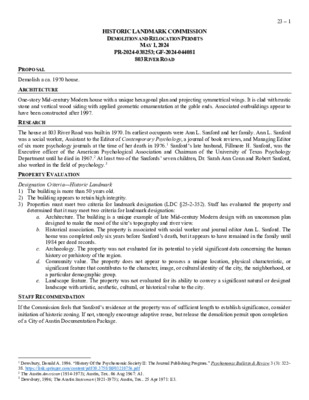22.0 - 803 River Rd — original pdf
Backup

HISTORIC LANDMARK COMMISSION DEMOLITION AND RELOCATION PERMITS MAY 1, 2024 PR-2024-038253; GF-2024-044081 803 RIVER ROAD 23 – 1 PROPOSAL Demolish a ca. 1970 house. ARCHITECTURE RESEARCH One-story Mid-century Modern house with a unique hexagonal plan and projecting symmetrical wings. It is clad with rustic stone and vertical wood siding with applied geometric ornamentation at the gable ends. Associated outbuildings appear to have been constructed after 1997. The house at 803 River Road was built in 1970. Its earliest occupants were Ann L. Sanford and her family. Ann L. Sanford was a social worker, Assistant to the Editor of Contemporary Psychology, a journal of book reviews, and Managing Editor of six more psychology journals at the time of her death in 1976.1 Sanford’s late husband, Fillmore H. Sanford, was the Executive officer of the American Psychological Association and Chairman of the University of Texas Psychology Department until he died in 1967.2 At least two of the Sanfords’ seven children, Dr. Sarah Ann Conn and Robert Sanford, also worked in the field of psychology.3 PROPERTY EVALUATION Designation Criteria—Historic Landmark 1) The building is more than 50 years old. 2) The building appears to retain high integrity. 3) Properties must meet two criteria for landmark designation (LDC §25-2-352). Staff has evaluated the property and determined that it may meet two criteria for landmark designation: a. Architecture. The building is a unique example of late Mid-century Modern design with an uncommon plan designed to make the most of the site’s topography and river view. b. Historical association. The property is associated with social worker and journal editor Ann L. Sanford. The home was completed only six years before Sanford’s death, but it appears to have remained in the family until 1984 per deed records. c. Archaeology. The property was not evaluated for its potential to yield significant data concerning the human history or prehistory of the region. d. Community value. The property does not appear to possess a unique location, physical characteristic, or significant feature that contributes to the character, image, or cultural identity of the city, the neighborhood, or a particular demographic group. e. Landscape feature. The property was not evaluated for its ability to convey a significant natural or designed landscape with artistic, aesthetic, cultural, or historical value to the city. If the Commission feels that Sanford’s residence at the property was of sufficient length to establish significance, consider initiation of historic zoning. If not, strongly encourage adaptive reuse, but release the demolition permit upon completion of a City of Austin Documentation Package. STAFF RECOMMENDATION 1 Dewsbury, Donald A. 1996. “History Of the Psychonomic Society II: The Journal Publishing Program.” Psychonomic Bulletin & Review 3 (3): 322– 38. https://link.springer.com/content/pdf/10.3758/BF03210756.pdf 2 The Austin American (1914-1973); Austin, Tex.. 06 Aug 1967: A1. 3 Dewsbury, 1996; The Austin Statesman (1921-1973); Austin, Tex.. 25 Apr 1971: E3. LOCATION MAP 23 – 2 PROPERTY INFORMATION Photos 23 – 3 23 – 4 Demolition permit application, 2024 Historical Information 23 – 5 1984 aerial photograph TCAD ownership summary 23 – 6 The Austin Statesman (1921-1973); Austin, Tex.. 07 Aug 1967: 22. The Austin American (1914-1973); Austin, Tex.. 06 Aug 1967: A1. 23 – 7 The Austin Statesman (1921-1973); Austin, Tex.. 25 Apr 1971: E3. The Austin American - Statesman (1973-1980), Evening ed.; Austin, Tex.. 04 Feb 1976: 51. The Austin American - Statesman (1973-1980), Evening ed.; Austin, Tex.. 03 Feb 1976: 8. Memory & Cognition, 1976: Vol, 4(2), 117. https://link.springer.com/content/pdf/10.3758/BF03213150.pdf?pdf=inline%20link 23 – 8 Clips from Dewsbury, Donald A. 1996. “History Of the Psychonomic Society II: The Journal Publishing Program.” Psychonomic Bulletin & Review 3 (3): 322–38. https://link.springer.com/content/pdf/10.3758/BF03210756.pdf.